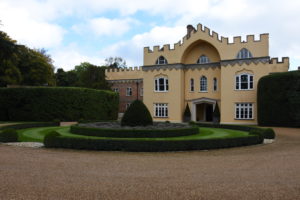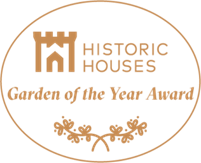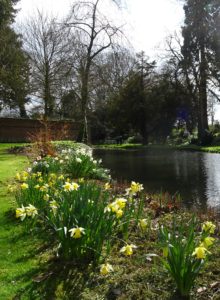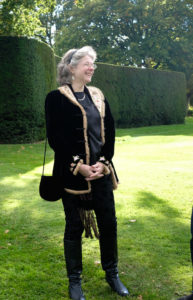 https://pbase.com/asbostaff/hampden_house_2024&view=slideshow
https://pbase.com/asbostaff/hampden_house_2024&view=slideshow
Slide show by John O’Dwyer
Bucks Gardens Trust: guided walk and lunch at Hampden House 30 April 2024
Around 30 members assembled on a glorious morning for coffee and biscuits in the delightful ‘Hill House’ at Hampden House (converted to a reception space from the House’s old brewery). It was laid out for us as if ready for an elegant banquet. We were greeted by Marie Helen Oliver representing the current family owners. Gwen Miles spoke briefly about the longevity of the Hampden family connection with the House and Estate (surviving opposition to the Stuart monarchy and the South Sea Bubble), matched only by the longevity of the landscape itself, starting in medieval times, being recast with the house after a tremendous storm in the 1730’s. Gwen referred to the effort needed by herself and her two collaborators in the Trust’s Research Project in preparing the report on Hampden House because of the huge wealth of records available.
The walk was guided by Gwen (history and designed landscape) and Michael Hunt (trees) who had evidently organised their double act very carefully. We started with the magnificent Cedar of Lebanon close to the west entrance front and its carriage sweep. Michael explained that its stupendous height and girth (almost 29m (95ft) and 11m (36ft) respectively) were thanks to its early date, c.1640. It was one of the first cedars to be planted in this country. The walk continued counter-clockwise round the house passing some renovation work on the rustic screen wall to the south of the house and to the stone quoins on the south corner of the house’s garden front which had been eroded following the application of render when the house was in use as a private girls’ school. Michael described the splendid main trees in the little wilderness on the south side including a yew, a tall lime and a distinctive Monterey pine that had started growing on a considerable slant but had corrected itself halfway up.
We crossed the lawn to the east of the house at the top of ‘The Glade’ the eastern avenue. Gwen explained that it was extended down to the road with the ‘pepperpot’ lodges following in 1743/4. We plunged into the woodland on the north side of the house, along a path kindly improved for us by the Estate with ash chippings on the softer areas. The ice house was open with for our inspection with lighting and with temporary guarding around its entrance, yet another example of the care and attention shown by the Oliver family during our visit.
The walk finished with a view eastwards where Gwen pointed out the features of the medieval park and their remarkable survival. Michael talked about the commercial side of the neighbouring wood where sitka spruce had been used for paper production and for building Mosquito planes during the war. Marie Helen said that the area will eventually replanted with native species.
We returned to Hill House for a lunch of warm quiche and salad (and a glass of wine) followed by rhubarb fool. After lunch we were invited over to the parish church and given an excellent talk by the Rev. Heywood on the ongoing restoration of the church. As a churchman first rather than as an historian, he was relieved that they had not found any wall painting or burials, though tiles from the famous medieval Penn tileworks had originally been laid in the church only to be broken up later and used as hardcore! Six undamaged examples have happily been laid in the chancel’s new floor.
The splendid weather, the location and the arrangements combined to make an extremely successful event.
Geoff Huntingford Bucks GT Committee member and Reseacher



